|
[Front Page] [Features] [Departments] [SGAP Home Page] [Subscribe]

The Naming Game
Bruce Rosier
What a story lies in a name!
I invite you to explore the hidden treasures that are to be found in plant names. From earliest times people have given names to the plants that they have come to know, plants that they may have used for food, for medicine, for hunting or for warfare.
You will recognise some at once - quandong, pituri, wandoo, ginseng, strawberry, apricot, basil, tomato, curare, quinine.
Our current system for plant names goes back to the great Carl Linnaeus (1707-1778). Linnaeus used Latin, as the international language of scholars in his day. Of course, before then there had been many descriptions of plants, and various texts with names and properties, particularly for medical use, but the advantage of Linnaeus’ system was that it could be used and understood by all students, and that while local or common names varied from place to place, the scientific, botanical, name was able to be used everywhere.
Each of the three parts of the plant name - that of the genus; that of the species, and that of the person who described the plant, can all tell us a great deal. We may learn something of the character and habit of the plant, its type of growth, its preferred habitat. We may learn something of the person who first collected it, or the botanist who described it, or those who were patrons of the expedition during which the plant was found. For such enquirers the history of exploration in the Pacific opens up, and then the history of the discovery of Australia, and its great variety - coastlands, deserts, tropics and alpine regions. Seeking the meaning of plants’ names unfolds the hidden treasures of this wonderful and very special continent. Since both Greek and Latin are used in botanical names, we may even have a glimpse of some ancient history- or, but more rarely, if a plant name has an Aboriginal epithet, then we may have a glimpse into that plant in an Aboriginal society.
 |
- Named but not validly published by Carl Meissner; validly published by Ferdinand Mueller
- Validly published by Charles Gardner
|
Let me begin with Banksia ornata. F. Muell. ex Meissner, used by the Society for Growing Australian Plants in South Australia for its logo.
- Banksia puts us in touch at once with Joseph Banks (1743-1820) and his fellow botanist, Daniel Solander (1733-1782), who sailed with Cook in the voyage of the "Endeavour" and who botanised in Eastern Australia during April, May and June 1770. Banks and Solander built up a large collection from that voyage, but published little, though they always welcomed other students to their collection. So the genus was named by the younger Carl Linnaeus, Lf. (1741-1783).
- ornata is 'handsome' or 'showy', Ferdinand Mueller’s (1825-1896) own response to the flowers. I think Mueller loved the beauty of trees and flowers!
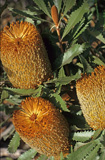 |
Banksia ornata is common in dry areas of South Australia and Victoria.
Select the thumbnail image or plant name for a higher resolution image (56k). Photo: Ivan Holliday
|
It was Mueller who named the Acacia notabilis, notabilis meaning 'outstanding' or 'remarkable' which has a fine flower and was collected near Mt. Remarkable. Mueller commented that this was the first time that ‘notabilis’ had been used as a botanical epithet!
Let us next look at Australia's first floral emblem, Acacia pycnantha Benth. The name of the genus is Greek; akis, 'a sharp point'.
- The specific name is from the Greek pyknos, 'thick', and anthos, 'flower', telling us about the flower cluster, which indeed has 50 to 80 flowers.
- 'Benth.’ tells us that it was first described by the great George Bentham (1800-1884) who produced the first Flora of Australia in 7 volumes from 1863 to 1878.
You will recognise akis also in the Hibbertia acicularis and H.exutiacies. Both have sharp pointed leaves, and exutiacies tells us that the points fall off - they 'exit'. So the name can give a clue to identifying the plant!
South Australia’s floral emblem was named Clianthus formosus (Don) Ford & Vick., but it is now Swainsona formosa (Don) J Thompson. This plant had first been collected by William Dampier (1652-1715) on his voyage to north west Australia in 1699 and described in his "Voyage to New Holland" in 1703. That specimen is still held by the Sherardian Herbarium in Oxford.
 |
The spectacular Swainsona formosa creates an eye-catching display.
Select the thumbnail image or plant name for a higher resolution image (43k).
|
- Clianthus is from the Greek kleos, 'glory', from the splendid flower, a name for the genus due to Solander which was published by John Lindley (1799-1865), Professor of Botany in London in the 1830s - Sol. ex Lindley.
- formosus is Latin for 'elegant'.
- '(Don)’ tells us that D. Don, (1800-1841), an English botanist, first described the plant after Linnaeus, but that it was revised by Ford & Vick in 1940, and then it was later moved to the close genus Swainsona by J. Thompson.
Even such a familiar plant as the type species of Eucalyptus - Eucalyptus obliqua (L’Her.) - tells a fascinating story. A story of exploration, of plant specimens and seeds collected, and brought back to England, of the tree grown at Kew, and of the dried specimens in Bank’s herbarium being recognised, and described as a new species by a French botanist, one of many who were welcomed to work in his herbarium by Sir Joseph.
Many plant names feature the colour of the flower, and a large variety of words for colours have been used. Since often a plant is inconspicuous until it flowers, the name gives us useful clues to the identity of the plant. Colour is used also for the grass trees, Xanthorrhoea from the yellow (xanthos) resin of some species.
This first phase of botany in Australia was European, and the type specimens were kept in Europe. As well as the English, French botanists also did some fine early work in Australia. Their names are recalled in Commersonia, Billardiera, Lechenaultia and Richea. Leucopogon richei recalls that Riche, botanical collector on D’Entrecasteaux’s expedition, survived by eating the fruit of this plant near Esperance. Correa honours a Portuguese botanist, and much fine work was done by German botanists, Priess, Diels and Pritzel in Western Australia and Behr, Wilhelm, Hillebrand and Osswald in South Australia. The fine illustration of Correa pulchella in Sweet’s 1827 "Flora Australasica" is from a plant grown from a seed collected by William Baxter on Kangaroo Island in 1822/1823.
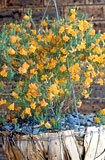 |
Lechenaultia formosa has many colourful forms.
Select the thumbnail image or plant name for a higher resolution image (39k).
|
With the arrival of Mueller and the establishment of the herbarium in Melbourne, botany became less centred in Europe and more Australian. More and more local people became involved and their names began to appear - Caleana, drummondii, cunninghamii, gunii, lawrenciana.
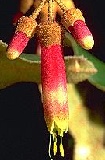 |
Correa lawrenciana commemorates Correa de Serra, a Portuguese botanist and R.W. Lawrence, a Tasmanian botanist.
Select the thumbnail image or plant name for a higher resolution image (24k).
|
However, please be careful and check! Hakea victoria and Grevillea victoriae are indeed named after the Queen, but Acacia victoriae is named after the Victoria River. A.mitchellii and other mitchelliana may be named after the explorer, Sir Thomas Mitchell, but the scarlet Verticordia mitchelliana is named after Sir James Mitchell, a governor of Western Australia who once held land close to where this plant was first collected about 1930.
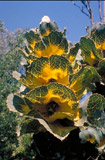 |
The colourful but bizarre foliage of Hakea victoria. Did Queen Victoria regard the naming of this species as a compliment??!!
Select the thumbnail image or plant name for a higher resolution image (43k).
|
Aboriginal names continue in Eucalyptus wandoo and Amyema quandangand Aboriginal remedies have been taken up by Europeans in Tea Tree Oil and Eucalyptus Oil. Aboriginal foods are now coming into use - not only quandongs, but also muntries, Kunzea pomifera and the mountain and alpine peppers, Drimus lanceolata and D.xerophila. The Flinders Ranges Aboriginal people, the Adnyamathanha people, enjoyed the flowers and fruit of Marsdenia australis syn. Leichhardtia australis, the Iga tree, Capparis mitchellii, as well as uti, the quandong.
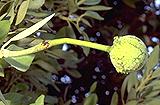 |
The developing fruits of the native orange, Capparis mitchellii.
Select the thumbnail image or plant name for a higher resolution image (29k).
|
Acknowledgement
I wish to thank Mr. Darrell Kraehenbuehl for all the help and encouragement he has given me in the preparation of this article.
This article is a reproduction of a paper presented at the SGAP 19th Biennial Seminar which was held at Annesley College, Adelaide, 30 September to 3 October 1997.
.Bruce Rosier is an Anglican minister who worked in the Western Wheatbelt parishes of Wyalkatchem and Kellerberrin, during which time he was fascinated by the variety and beauty of the trees and flowers. He began to learn their names, using Blackall’s "How to Know West Australian Wildflowers". He also began to collect specimens for the West Australian Herbarium, who would determine the names for him, so in this way his knowledge slowly grew. He became friendly with Charles Gardner, the government botanist, and with Bob Royce, his assistant, both of whom taught him a great deal.
He then moved to work as a bishop in the north of South Australia, and in addition to his duties he had much pleasure in learning more of the local flora. Having always enjoyed words and their meanings, he began to learn what plant names mean, and "what an interesting and continuing journey that has been".

[Front Page] [Features] [Departments] [SGAP Home Page] [Subscribe]
Australian Plants online - December 1998
The Society for Growing Australian Plants
|